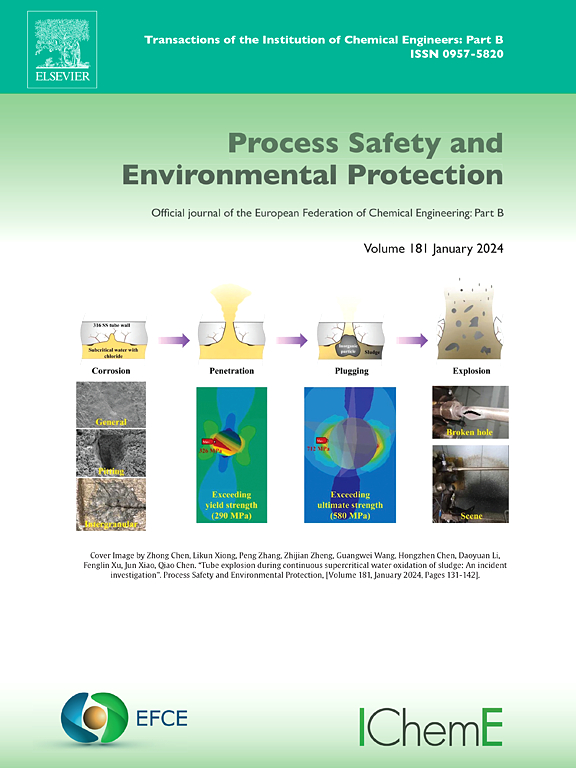Salt-laden pharmaceutical industry reverse osmosis reject wastewater treatment using halotolerant biocatalyst integrated heterogeneous activated carbon fenton catalytic oxidation process
IF 6.9
2区 环境科学与生态学
Q1 ENGINEERING, CHEMICAL
引用次数: 0
Abstract
Pharmaceutical reverse osmosis reject (PROR), a retentate generated during the reverse osmosis process of pharmaceutical effluent treatment, comprises high concentration of toxic active pharmaceutical ingredients (APIs) coupled with high salinity and total dissolved solids (TDS). These properties make the treatment of RO reject challenging for conventional technologies. The current study designs a novel strategy to accelerate PROR effluent treatment using a strategically designed biostimulant-mediated halotolerant biocatalytic oxidation (BMHBO) system coupled with Heterogeneous activated carbon Fenton catalytic oxidation (HAFCO) system. The identified halotolerant microbial system comprised Bacillus cereus OR186720, Bhargavaea indica OR186702, Bacillus paramycoides OR186695, and Lysinibacillus macroides OR186663, as determined by 16S rRNA analyses. The efficiency of the integrated system, evidenced by COD, TDS, and salinity reductions of 98.11 %, 91.66 %, and 54.51 %, respectively, was further validated through FT-IR, 1H NMR, GC-MS, EDX, and XRF analyses. The present study demonstrated that the integrated treatment systems of BMHBO and HAFCO achieved accelerated treatment of PROR wastewater by overcoming the harmful interference posed by elevated TDS content without the generation of secondary pollution.
采用耐盐生物催化剂集成多相活性炭fenton催化氧化工艺处理含盐制药工业废水
制药反渗透废液(PRROR)是制药废水处理反渗透过程中产生的一种回流液,含有高浓度的有毒活性药物成分(API)以及高盐度和总溶解固体(TDS)。这些特性使得反渗透废水的处理对传统技术来说具有挑战性。目前的研究设计了一种新策略,利用战略性设计的生物刺激剂介导的耐盐生物催化氧化(BMHBO)系统与异质活性炭芬顿催化氧化(HAFCO)系统相结合,加速 PROR 污水的处理。根据 16S rRNA 分析,确定的耐卤微生物系统包括蜡样芽孢杆菌 OR186720、靛红芽孢杆菌 OR186702、副溶血性芽孢杆菌 OR186695 和大肠杆菌 OR186663。通过傅立叶变换红外光谱(FT-IR)、1H NMR、气相色谱-质谱(GC-MS)、电子显微镜(EDX)和 X 射线荧光光谱(XRF)分析,COD、TDS 和盐度分别降低了 98.11 %、91.66 % 和 54.51 %,进一步验证了综合系统的效率。本研究表明,BMHBO 和 HAFCO 的综合处理系统克服了 TDS 含量升高带来的有害干扰,实现了对 PROR 废水的加速处理,且不会产生二次污染。
本文章由计算机程序翻译,如有差异,请以英文原文为准。
求助全文
约1分钟内获得全文
求助全文
来源期刊

Process Safety and Environmental Protection
环境科学-工程:化工
CiteScore
11.40
自引率
15.40%
发文量
929
审稿时长
8.0 months
期刊介绍:
The Process Safety and Environmental Protection (PSEP) journal is a leading international publication that focuses on the publication of high-quality, original research papers in the field of engineering, specifically those related to the safety of industrial processes and environmental protection. The journal encourages submissions that present new developments in safety and environmental aspects, particularly those that show how research findings can be applied in process engineering design and practice.
PSEP is particularly interested in research that brings fresh perspectives to established engineering principles, identifies unsolved problems, or suggests directions for future research. The journal also values contributions that push the boundaries of traditional engineering and welcomes multidisciplinary papers.
PSEP's articles are abstracted and indexed by a range of databases and services, which helps to ensure that the journal's research is accessible and recognized in the academic and professional communities. These databases include ANTE, Chemical Abstracts, Chemical Hazards in Industry, Current Contents, Elsevier Engineering Information database, Pascal Francis, Web of Science, Scopus, Engineering Information Database EnCompass LIT (Elsevier), and INSPEC. This wide coverage facilitates the dissemination of the journal's content to a global audience interested in process safety and environmental engineering.
 求助内容:
求助内容: 应助结果提醒方式:
应助结果提醒方式:


